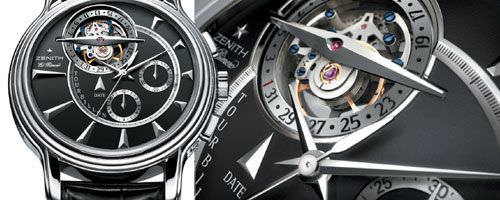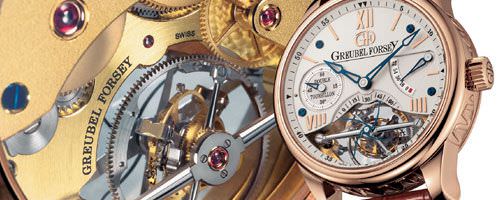Since Breguet invented it, the tourbillon has intrigued watchmakers and preoccupied their waking hours almost as much as a biologist’s fascination as to why lemmings commit mass suicide by throwing themselves off a cliff.

Photo: GRANDE CHRONOMASTER XXT TOURBILLON by Zenith - After three years of reasearch and development, the master watchmakers and technicians of Zenith with the ‘hands-on’ influence/participation of Thierry Nataf, the brand’s CEO, offer us the only automatic chronograph movement with tourbillon that functions at the vertiginous speed of 36,000 vibrations per hour.
18 carat white gold case (45 mm) equipped with a new El Primero Calibre 4005 movement. The tourbillon carriage is placed at 11 o’clock, the date indication is placed around the carriage, sapphire crystals front and back, 22 carat white gold oscillating weight with Côtes de Genève pattern, central seconds hand, 30-minute counter at 3 o’clock, 12-hour counter at 6 o’clock, measurements of short time intervals to a 10th of a second, white gold appliqué 3-dimensional indices in progressive size, white gold facetted hands. Black alligator strap with white gold ChronoMaster triple folding buckle, water-resistant to 30 metres.
The delicate tourbillon mechanism is considered to be one of the most complex watch complications to make since it was conceived to compensate for the loss of the watch’s precision caused by gravity. The tourbillon rotates clockwise and passes through every position of a complete circle in order to eliminate the effects of gravity on the balance wheel movement and as it does so, it adjusts the watch movement’s precision.
Mechanicals make a comeback
Despite Omega being one of the first brands to produce a tourbillon wristwatch way back in 1947, the tourbillon in a wristwatch remained a rarity until just a few years ago, simply because the wristwatch is subjected to many varying movements and therefore requires less adjustment to counter the effects of gravity. This type of complication was reserved for the pocket watch since most of the time it was in a static vertical position in a pocket and was in need of a precision adjustment.
It really wasn’t until the quartz revolution levelled out in the 80s that the mechanical watch began to make a slow comeback. And then came the revolution. The tic of the mechanical watch was no longer a nostalgic memory, it re-surfaced and was in demand again. As the resurgence of mechanical watches gained pace, so those manufacturers capable of creating them strove to introduce new and more complex complications into their timepieces in order to stay ahead of the game. Aficionados and collectors had a field day, but the ultimate complication, the tourbillon, still remained a rarity.
But progress (no pun intended) can’t be held back and today, many brands offer a wristwatch with a tourbillon. The genuine watch manufacturers – or the ‘manufactures’ as we now tend to call them – are justly proud of their ‘homemade’ mechanical movements and the introduction of a tourbillon to their collections not only underlines their horological prowess, but also emphasizes the justification of their ‘manufacture’ sobriquet.
However, several excellent brands that don’t actually manufacture their own movements but modify and assemble those supplied by movement manufacturers according to their requirements, have also acquired a tourbillon. For them, the costly end product (prices range anywhere from 60,000 to 250,000 Swiss francs) justifies the means since with a tourbillon in their collection they are more often than not considered by consumers as being a part of the watchmaking elite. Rightly or wrongly, they are looked upon as bona fide manufacturers.
Don’t get me wrong, even a tourbillon manufactured by a specialist movement manufacturer like Christophe Claret and ‘imported’ into another brand’s case doesn’t detract from the finished article. Although there are many different tourbillons, a tourbillon is a tourbillon, a miniature horological masterpiece, but it is those that emanate from a genuine ‘manufacture’, or the few independent watchmakers capable of creating and assembling their own, that are highly sought after by the purists.

Photo: DOUBLE TOURBILLON 30º by Greubel Forsey - Created by two independent watchmakers, Robert Greubel and Stephen Forsey who have started their own company, this innovative timepiece is equipped with their very first movement. After four years of work and research the innovative Double Tourbillon 30º is a tourbillon within a tourbillon and is so named because of the angle that connects the two mobile cages.
18 carat red gold case with a domed sapphire crystal front and back. 301 components, 21,600 vph, small tourbillon at 30º, 1 rotation per minute with indicator at 9 o’clock, large tourbillon, 1 rotation every 4 minutes indicated above the tourbillon at 6 o’clock, 72-hour power reserve indicator at 3 o’clock, water-resistant to 30 metres. Diameter: 43.5 mm, height: 15.76 mm.
Tourbillons in abundance
Last year alone, we wrote about 16 different models in one article alone - Tourbillons: 2003 was a bountiful year (Europa Star 4/2003) and discovered some superb pieces by brands like Arnold & Son, Chopard, Jorg Hysek, Piaget and Jaeger-LeCoutre to name just a few. There were also five companies that presented extraordinarily ingenious tourbillons: Antoine Preziuso’s diamond-encrusted Popstar with its skeleton movement, Franck Muller with the fascinating Revolution II that turned on two axes, the first axis for the conventional one-minute revolution and the second axis for an eight-minute revolution whereby the cage turns 360º; François-Paul Journe’s stunning Tourbillon Souverain that had the added complication of a constant-force remontoir; Audemars Piguet with its Edward Piguet Tourbillon, Power Reserve Indicator & Dynamograph (a visible mainspring torque indicator); and last but not least, Patek Philippe’s 10 day Tourbillon with it’s tourbillon visible only through the sapphire caseback which seemed to declare ‘We don’t need to flaunt ours!’
But let’s get back to the present. So far, at the time of writing this article (four weeks before BaselWorld and the SIHH), we at Europa Star have already been informed of seven new tourbillons from Antoine Preziuso (see ‘Antoine Preziuso: Moving fast... slowly’ in this issue), DeWitt (see ‘The passion of DeWitt’ in this issue), Greubel Forsey, Louis Vuitton, Movado, Thomas Prescher (photos and technical details were not available in time for publication) and Zenith.
It’s certain that there will be others that will be revealed for the first time at the forthcoming annual happenings, but this is a sneak preview of those brands that adventurously sent us details prior to their official unveiling …






